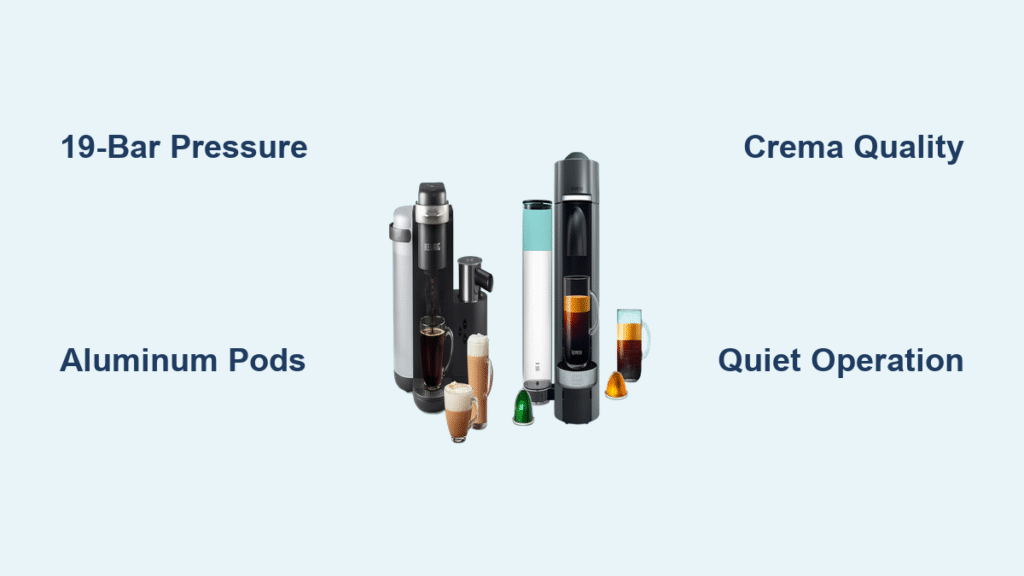You pull up to the coffee machine counter at your friend’s house, only to find two sleek devices that look suspiciously similar. Yet when she hands you an espresso with velvety crema while you’re used to Keurig’s drip-style brew, you realize how is nespresso different from keurig isn’t just marketing hype—it’s a fundamental divide in coffee philosophy. This isn’t about which brand is “better,” but which system aligns with your actual coffee habits, budget, and morning ritual.
If you’ve ever stared at grocery store shelves overflowing with K-Cups while wondering why Nespresso pods cost twice as much, you’ve hit the core tension. The truth is these systems serve completely different purposes: Nespresso delivers authentic espresso experiences with European precision, while Keurig optimizes for grocery-store convenience and variety. Understanding these distinctions prevents costly mistakes—like buying a Nespresso machine expecting drip coffee or choosing Keurig for true espresso shots. Let’s cut through the confusion with actionable comparisons that reveal exactly where these systems diverge.
Espresso Pressure vs Drip-Style Extraction

Why 19 Bars Beats 3 Bars for Real Espresso
Nespresso’s OriginalLine machines use professional-grade 19-bar pressure pumps—the exact standard in Italian espresso bars—to force hot water through densely packed coffee pucks. This high-pressure extraction releases aromatic oils and creates that signature golden crema layer (up to 5mm thick) you can’t get from drip methods. VertuoLine takes a different approach: its centrifugal “Centrifusion” technology spins pods at 7,000 RPM while applying lower pressure, blending extraction time and water saturation for both espresso and larger coffee servings.
Keurig systems operate at just 2-3 bars of pressure—comparable to standard drip coffee makers. Even with MultiStream technology’s five water jets (found in K-Supreme and K-Elite models), the water simply trickles through looser grounds rather than forcing extraction. This fundamental difference explains why Keurig’s “strong” or “shot” settings only produce concentrated drip coffee, not true espresso. You’ll get a bolder cup, but never the rich body or crema that defines authentic espresso.
Cup Size Realities You Won’t Find in Advertisements
Nespresso’s size capabilities depend entirely on the pod format:
– OriginalLine: Strictly espresso-focused (1.35-2.7 oz shots)
– VertuoLine: Spans true espresso (1.35 oz) to coffee (5-18 oz), with carafe pods for 18-ounce servings
Keurig offers broader drip-style ranges (4-12 oz single serve) and carafe models like the K-Duo that brew 30-ounce pots. But crucially, Keurig’s smallest 4-ounce setting still lacks espresso characteristics—without high pressure, you’re just getting weaker drip coffee in a tiny cup. If you regularly order cappuccinos or lattes at cafes, only Nespresso delivers that concentrated espresso base needed for proper milk-based drinks.
Aluminum Pods vs Plastic K-Cups: A Hidden Cost Battle

Nespresso’s Premium Pod Ecosystem
Nespresso pods cost significantly more ($0.80-$1.60 per serving) because they’re engineered for performance. OriginalLine pods use aluminum with silicone lining and accept third-party brands like Starbucks and L’OR. VertuoLine pods are proprietary domes with barcode technology—only Nestlé and licensed Starbucks pods work due to the machine’s automatic size/temperature calibration. The aluminum construction enables Nespresso’s free recycling program: pre-paid UPS bags arrive with online orders, and NYC/NJ users can even toss pods in curbside bins.
Keurig’s Grocery Store Advantage (With Tradeoffs)
K-Cups dominate grocery aisles ($0.33-$1.10 per cup) with 500+ varieties across 75+ brands—from Dunkin’ to McDonald’s to specialty roasters. But that convenience comes with environmental baggage: the #5 plastic cups require foil separation before recycling (a step most skip), and Keurig’s paid mail-back program sees minimal adoption. While the My K-Cup reusable filter offers a ground coffee alternative, its loose grounds produce inconsistent results compared to Nespresso’s precision-packed pods.
Machine Design: Quiet Elegance vs Bulk Convenience
Nespresso’s European Engineering
Nespresso machines prioritize compactness and quiet operation (VertuoLine runs at 70 dB—about as loud as a shower). Chrome finishes and matte colors dominate, with De’Longhi and Breville manufacturing under strict design standards. Even entry models like the Vertuo Pop ($99) feature smaller footprints ideal for countertops, while premium Lattissima models ($350+) integrate Aeroccino milk frothers for one-touch lattes. The tradeoff? Limited availability—you’ll only find them at Nespresso boutiques, select Target stores, or online.
Keurig’s Practical Plastic Reality
Keurig machines embrace colorful plastic bodies with bulkier footprints but wider accessibility. The K-Mini ($49) squeezes into tight spaces at just 5 inches wide, while K-Supreme models ($150) boast 78-ounce water tanks perfect for offices. You’ll find them everywhere—from gas stations to Costco—but this ubiquity sacrifices refinement. Most units require manual pod removal after each brew and lack the premium feel of Nespresso’s metal components, though newer models like the K-Café include milk frothers (delivering foam but still on drip-strength coffee).
Daily Rituals: One-Touch Simplicity vs Button-Heavy Control
Nespresso’s Set-and-Forget Workflow
VertuoLine machines read pod barcodes automatically—just drop in a pod, close the lid, and press one button. Used pods eject into an 8-10 capsule bin, and descaling takes just 5 minutes every 300 pods. The entire process feels like operating a high-end espresso machine: minimal interaction, maximum consistency. OriginalLine requires slightly more input (selecting shot size), but still avoids constant button pressing.
Keurig’s Manual Adjustment Reality
Every Keurig brew demands size and strength selections—pressing “strong” for espresso-like intensity, then choosing 4 oz, then confirming. You’ll manually remove each pod after brewing, and descaling involves a 30-minute cycle with proprietary solution. While this offers more customization (e.g., adjusting temperature on K-Supreme models), it turns coffee-making into a multi-step chore. Shared office environments exacerbate this: someone inevitably leaves a pod stuck inside or forgets to refill the water tank.
Environmental Impact: Aluminum Recycling vs Plastic Challenges
Nespresso’s aluminum pods achieve over 90% recyclability through their free program—simply toss used pods in included UPS bags. Nestlé claims carbon-neutral capsule delivery, justifying the premium cost. Keurig’s plastic K-Cups present a steeper challenge: despite #5 plastic recyclability, most users discard them whole because foil separation is tedious. Keurig Dr Pepper promises 100% recyclable K-Cups by 2025, but current adoption remains low. The My K-Cup reusable filter helps, but inconsistent grind sizes often clog machines—a problem Nespresso avoids with precision-engineered pods.
True Cost Comparison Beyond the Price Tag

Upfront Machine Costs
- Nespresso: Entry Vertuo Pop ($99-$110) to premium Lattissima ($350+)
- Keurig: K-Mini ($49-$65) to K-Café ($150-$180)
Keurig wins on initial affordability, but Nespresso machines retain 40-50% resale value after two years versus Keurig’s 25-30%. Nespresso’s 2-year warranty also outperforms Keurig’s standard 1-year coverage (though Keurig offers paid extensions).
Long-Term Ownership Reality
At $0.80 per Nespresso pod versus Keurig’s $0.50 average, Keurig saves about $100 annually for daily users. But factor in Nespresso’s faster descaling (5 minutes vs 30), free recycling, and higher resale value, and the gap narrows. Crucially, Nespresso’s VertuoLine auto-eject feature prevents the “forgotten pod” mold issues that plague Keurig users—a hidden maintenance cost worth considering.
Who Should Actually Choose Which System
Choose Nespresso If You…
- Crave authentic espresso with thick crema for lattes/cappuccinos
- Prefer ordering pods online (Nespresso.com, Starbucks)
- Value quiet operation and sleek countertop design
- Prioritize environmental programs with hassle-free recycling
- Drink 1-2 specialty coffees daily (not 3+ drip cups)
Choose Keurig If You…
- Need grocery-store pod access for last-minute runs
- Brew tea, hot cocoa, or variety drinks multiple times daily
- Prefer drip-style coffee strength across multiple cup sizes
- Manage shared office kitchens with diverse drink preferences
- Want the absolute lowest cost per cup ($0.33 for Costco bulk)
Make Your Decision in 60 Seconds
| Your Morning Priority | Nespresso or Keurig? |
|---|---|
| “I want cafe-quality espresso shots” | Nespresso (Vertuo/Original) |
| “I need pods at 10pm from gas stations” | Keurig |
| “I hate recycling hassles” | Nespresso |
| “I brew 3+ cups daily for the family” | Keurig (carafe models) |
| “I prioritize machine resale value” | Nespresso |
| “I drink mostly iced coffee/tea” | Keurig |
Stop Comparing—Start Choosing Your Perfect System
The real answer to how is nespresso different from keurig boils down to one question: Do you want espresso or drip coffee? If you’ve ever paid $5 for a caramel macchiato and thought “I could make this at home,” Nespresso delivers that experience with minimal effort—especially with Aeroccino frothers creating authentic milk textures. But if your ideal morning involves grabbing any pod from the pantry for a quick drip cup, Keurig’s grocery dominance and lower cost per cup win.
Ignore the marketing noise about “single-serve convenience”—both systems offer that. Instead, align your choice with your actual coffee behavior. Test pods first: order Nespresso’s Vertuo espresso and Keurig’s K-Café “shot” side-by-side. The physical experience—crema thickness, body, aftertaste—will reveal more than any spec sheet. When you match the machine to your ritual, not the other way around, you’ll finally get that perfect cup without buyer’s remorse.



